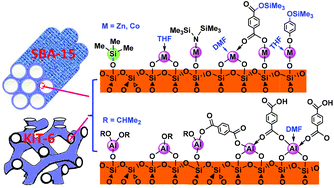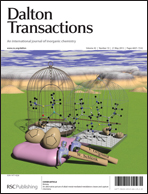Functionalization of large-pore periodic mesoporous silicas: metal silylamide and isopropoxide molecular grafting and secondary surface ligand exchange†
Abstract
Divalent metal silylamide complexes of zinc and cobalt and trivalent aluminium isopropoxide were successfully grafted onto large-pore hexagonal channel-like SBA-15 and cubic MCM-48-like periodic mesoporous silica (PMS) KIT-6, to afford hybrid materials Zn[N(SiMe3)2]2@SBA-15, Co[N(SiMe3)2]2(thf)@SBA-15/KIT-6 and {Al(OCHMe2)3}@SBA-15 with well-defined surface species (![[triple bond, length as m-dash]](https://www.rsc.org/images/entities/char_e002.gif) SiO)2M(thf)x,
SiO)2M(thf)x, ![[triple bond, length as m-dash]](https://www.rsc.org/images/entities/char_e002.gif) SiOM[N(SiMe3)2](THF)x (x = 0, M = Zn; x = 1, M = Co),
SiOM[N(SiMe3)2](THF)x (x = 0, M = Zn; x = 1, M = Co), ![[triple bond, length as m-dash]](https://www.rsc.org/images/entities/char_e002.gif) SiOSiMe3 and (
SiOSiMe3 and (![[triple bond, length as m-dash]](https://www.rsc.org/images/entities/char_e002.gif) SiO)2Al(OCHMe2) and
SiO)2Al(OCHMe2) and ![[triple bond, length as m-dash]](https://www.rsc.org/images/entities/char_e002.gif) SiOAl(OCHMe2)2, respectively. Surface silylamido ligand exchange with 1,4-benzenediol, 1,4-benzenedicarboxylic acid, and biphenyl-4,4′-dicarboxylic acid gave hybrid materials of type
SiOAl(OCHMe2)2, respectively. Surface silylamido ligand exchange with 1,4-benzenediol, 1,4-benzenedicarboxylic acid, and biphenyl-4,4′-dicarboxylic acid gave hybrid materials of type ![[triple bond, length as m-dash]](https://www.rsc.org/images/entities/char_e002.gif) SiOML(solvent)x and (
SiOML(solvent)x and (![[triple bond, length as m-dash]](https://www.rsc.org/images/entities/char_e002.gif) SiO)2M(solvent)x (L = O(C6H4)OSiMe3, O2C(C6H4)CO2SiMe3, O2C(C6H4)2CO2SiMe3; M = Zn and Co) revealing in situ ligand silylation as a side reaction. Surface isopropoxide/carboxylato ligand exchange generated species (
SiO)2M(solvent)x (L = O(C6H4)OSiMe3, O2C(C6H4)CO2SiMe3, O2C(C6H4)2CO2SiMe3; M = Zn and Co) revealing in situ ligand silylation as a side reaction. Surface isopropoxide/carboxylato ligand exchange generated species (![[triple bond, length as m-dash]](https://www.rsc.org/images/entities/char_e002.gif) SiO)2AlL(DMF)x and
SiO)2AlL(DMF)x and ![[triple bond, length as m-dash]](https://www.rsc.org/images/entities/char_e002.gif) SiOAl(OCHMe2)2−yLy (L = O2C(C6H4)CO2H, y ≤ 2) devoid of any secondary functionalization (such as formation of ester groups), offering a potential approach to PMS-encapsulated metal–organic frameworks. All featured surface species were verified by 1H, 13C and 29Si magic angle spinning (MAS) NMR and diffuse reflectance infrared Fourier-transform (DRIFT) spectroscopy as well as elemental analysis. Additionally, preservation of the long-range ordered mesostructures was proven by powder X-ray diffraction (PXRD), nitrogen physisorption, and transmission electron microscopy (TEM).
SiOAl(OCHMe2)2−yLy (L = O2C(C6H4)CO2H, y ≤ 2) devoid of any secondary functionalization (such as formation of ester groups), offering a potential approach to PMS-encapsulated metal–organic frameworks. All featured surface species were verified by 1H, 13C and 29Si magic angle spinning (MAS) NMR and diffuse reflectance infrared Fourier-transform (DRIFT) spectroscopy as well as elemental analysis. Additionally, preservation of the long-range ordered mesostructures was proven by powder X-ray diffraction (PXRD), nitrogen physisorption, and transmission electron microscopy (TEM).


 Please wait while we load your content...
Please wait while we load your content...